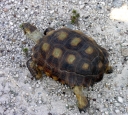Texas Tortoise (Gopherus berlandieri)
Description: The Texas tortoise adults reach a shell length up to 8.75 inches. The carapace is is rounded in dorsal perspective it is almost as wide as it is long and ranges in coloration from dark brown with beige highlights appearing on the center of the costal and vertebral scutes and on the edges of the marginal scutes. The plastron is colored similarly to the carapace with dark brown to black present on the edge of the plastral scutes distal to the mid-line. The head, neck and limbs are can range in coloration from tan to dark brown with some specimens exhibiting black scales on the front of the limbs and bottom of the feet. A pair of mental glands can be seen on the lower jaws of adult specimens.
Habitat: Open scrub woods, arid brush, lomas, grass-cactus association; often in areas with sandy well-drained soils. When inactive occupies shallow depressions dug at base of bush or cactus; sometimes in underground burrow or under object. Eggs are laid in nests dug in soil near or under bushes; nest may be dug in same spot in successive years
Range: G. berlandieri is found from southern Texas southward into the Mexican states of Coahuila, Nuevo León, and Tamaulipas.
Found in these States:
TX
Diet: Eats mainly cacti, grasses, and forbs; sometimes eats insects, land snails, and tortoise and rabbit feces.
Reproduction: Lays groups of one to several eggs in spring and summer. In southern Texas, egg production began in Apr., ended in July; females apparently partitioned the laying of their single clutch in time and space; about 1/3 of females did not produce a clutch in a given year; clutch size 1-5. Eggs hatch in 3-4 months. Has the slowest growth rate of any GOPHERUS; estimated mean age of sexal maturity is 13.3 years
Status: Though considered an animal of low concern by the IUCN Red List, the Texas tortoise is listed as a threatened species in the state of Texas, and thus protected by state law. It is illegal to collect or possess them. The Mexican federal government list Gopherus berlandieri as A (= Threatened) in Mexico. Likewise, using Environmental Vulnerability Scores, Gopherus berlandieri scored 18, a high vulnerability species on a scale of 0-20, in evaluations of both Tamaulipas and Nuevo Leon herpetofauna. In 2018, the IUCN Tortoise and Freshwater Turtle Specialist Group recommended a re-assessment and re-classification of all six Gopherus species. This reclassification would move G. berlandieri from Near Endangered (NE) to Near Threatened (NT).
»» Kingdom: Animalia - Animals
»» Phylum: Chordata - Chordates
»» Subphylum: Vertebrata - Vertebrates
»» Class: Reptilia - Reptiles
»» Order: Testudines - Turtles & Tortoises
»» Family: Testudinidae - Tortoises
»» Genus: Gopherus
»» Species: Gopherus berlandieri - Berlandier's Tortoise
»» Subspecies: None
This article uses material from the Wikipedia article "Texas Tortoise", which is released under the Creative Commons Attribution-Share-Alike License 3.0. Content may have been omitted from the original, but no content has been changed or extended.
|







